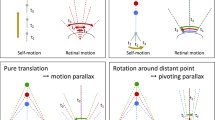Abstract
Nearly all animals with good vision have a repertoire of eye movements. The majority show a pattern of stable fixations with fast saccades that shift the direction of gaze. These movements may be made by the eyes themselves, or the head, or in some insects the whole body. The main reason for keeping gaze still during fixations is the need to avoid the blur that results from the long response time of the photoreceptors. Blur begins to degrade the image at a retinal velocity of about 1 receptor acceptance angle per response time. Some insects (e.g. hoverflies) stabilise their gaze much more rigidly than this rule implies, and it is suggested that the need to see the motion of small objects against a background imposes even more stringent conditions on image motion. A third reason for preventing rotational image motion is to prevent contamination of the translational flow-field, by which a moving animal can judge its heading and the distances of objects. Some animals do let their eyes rotate smoothly, and these include some heteropod molluscs, mantis shrimps and jumping spiders, all of which have narrow linear retinae which scan across the surroundings. Hymenopteran insects also rotate during orientation flights at speeds of 100–200° s−1. This is just consistent with a blur-free image, as are the scanning speeds of the animals with linear retinae.
Similar content being viewed by others
Explore related subjects
Discover the latest articles and news from researchers in related subjects, suggested using machine learning.Author information
Authors and Affiliations
Additional information
Accepted: 29 April 1999
Rights and permissions
About this article
Cite this article
Land, M. Motion and vision: why animals move their eyes. J Comp Physiol A 185, 341–352 (1999). https://doi.org/10.1007/s003590050393
Issue Date:
DOI: https://doi.org/10.1007/s003590050393




